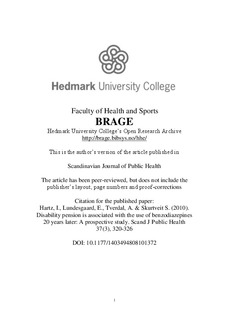| dc.contributor.author | Hartz, Ingeborg | |
| dc.contributor.author | Lundesgaard, Eldar | |
| dc.contributor.author | Tverdal, Aage | |
| dc.contributor.author | Skurtveit, Svetlana | |
| dc.date.accessioned | 2010-10-14T16:29:50Z | |
| dc.date.available | 2010-10-14T16:29:50Z | |
| dc.date.issued | 2009 | |
| dc.identifier.citation | Hartz, I., Lundesgaard, E., Tverdal, A. & Skurtveit S. (2010). Disability pension is associated with the use of benzodiazepines 20 years later: A prospective study. Scand J Public Health 37(3), 320-326 | en_US |
| dc.identifier.issn | 1403-4948 | |
| dc.identifier.uri | http://hdl.handle.net/11250/134240 | |
| dc.description | The original publication is available at: http://dx.doi.org/10.1177/1403494808101372 | en_US |
| dc.description.abstract | Aim: The Norwegian government states that actions are needed to stimulate working capacity in disability pension (DP) recipients with such a potential. Identification of factors that may impair rehabilitation efforts, such as information on the start of benzodiazepines in DP recipients, may be useful in this context.Thus, the aim of the study was to describe the association between receipt of DP and later prescriptions of benzodiazepines among non-users at baseline. Methods: We followed a cohort reporting non-use of benzodiazepines, 6645 men and 6455 women aged 40—42 years who underwent health surveys in 1985—89 in two Norwegian counties, with respect to subsequent use of benzodiazepines by linkage to the Norwegian Prescription Database for 2004—2006. At baseline, 83 men and 163 women reported receiving DP. Results: In both genders, the proportion started on at least one prescription of a benzodiazepine was approximately doubled among those reporting being on a DP 20 years in the past, 21% of all men and 29% of all women, respectively. Univariate odds ratios for a benzodiazepine prescription for men and women on a DP were 2.6 (95% confidence interval (CI) = 1.5—4.4) and 2.1 (95% CI = 1.5—2.9), respectively, as compared with those not receiving a DP. After adjustment for alcohol use, smoking habits, physical activity, socioeconomic and health variables, the odds ratios were lowered for both genders, being 2.1 (95% CI = 1.2—3.7) (men) and 1.6 (95% CI = 1.1—2.3) (women). Conclusions: For both men and women, the chance of being prescribed benzodiazepines was higher among those reporting being DP recipients 20 years in the past. | en_US |
| dc.language.iso | eng | en_US |
| dc.publisher | Scandinavian Journal of Public Health | en_US |
| dc.subject | Benzodiazepines | en_US |
| dc.subject | disability pension | en_US |
| dc.subject | employment status | en_US |
| dc.subject | longitudinal studies | en_US |
| dc.subject | pharmacoepidemiology | en_US |
| dc.subject | prescription database | en_US |
| dc.subject | epidemologi | en_US |
| dc.title | Disability pension is associated with the use of benzodiazepines 20 years later: A prospective study | en_US |
| dc.type | Journal article | en_US |
| dc.type | Peer reviewed | en_US |
| dc.subject.nsi | VDP::Medical disciplines: 700::Health sciences: 800::Community medicine, Social medicine: 801 | en_US |
| dc.subject.nsi | VDP::Medical disciplines: 700::Basic medical, dental and veterinary science disciplines: 710::Pharmacognosy: 738 | en_US |
| dc.source.pagenumber | 320-326 | en_US |
| dc.identifier.doi | http://dx.doi.org/10.1177/1403494808101372 | |
